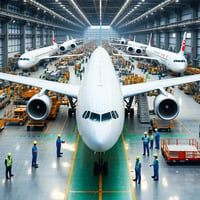The Need for Insurance Reform in the Aviation Industry The aviation industry, particularly small...
The Case for Investigating Aviation Insurance Antitrust Practices
Renewed Scrutiny Needed: The Case for Investigating Aviation Insurance Antitrust Practices
Aviation insurance is a critical component of the industry, ensuring financial protection for pilots, aircraft owners, and operators. However, the industry has a long history of alleged anticompetitive practices, including price-fixing, market allocation, and collusion. Several high-profile antitrust actions have targeted aviation insurance firms in the past, but today’s market conditions suggest that similar issues may still be present. With rising premiums, limited competition, and opaque underwriting criteria, it is time for renewed regulatory scrutiny to protect consumers and ensure a fair marketplace.
Historical Antitrust Actions Against Aviation Insurance Providers
1940s: The Civil Aeronautics Board Investigations
In the post-World War II era, as civil aviation expanded rapidly, concerns arose about the monopolistic behavior of aviation insurers. The Civil Aeronautics Board (CAB), which regulated the industry at the time, investigated allegations that a handful of firms were controlling the market and suppressing competition. The CAB found that major insurers had engaged in restrictive practices that limited options for aircraft owners and airlines, though formal legal action was not pursued.
1970s: The Lloyd’s of London Cartel Allegations
Lloyd’s of London, one of the dominant players in global aviation insurance, was accused of operating as a cartel that coordinated rates among its syndicates, effectively eliminating price competition. U.S. regulators scrutinized whether this practice harmed domestic insurers and increased costs for American aviation businesses. Although no major penalties were levied at the time, these concerns set the stage for later investigations.
1990s: DOJ Antitrust Probe into Aviation Insurance Brokers
One of the most significant antitrust actions against the aviation insurance industry occurred in the 1990s, when the U.S. Department of Justice (DOJ) launched an investigation into major insurance brokers, including Marsh & McLennan and Aon. The DOJ alleged that these brokers colluded with underwriters to manipulate bids, steer clients toward preferred insurers, and inflate premiums.
A key aspect of the case involved the practice of “follow-form” policies, where major insurers would simply match each other’s rates and terms rather than compete. This effectively eliminated price competition and allowed insurers to maintain artificially high premiums. The investigation resulted in settlements and reforms within the brokerage industry, but it did not completely eliminate concerns about market concentration.
2005: The Marsh & McLennan Bid-Rigging Scandal
In one of the largest insurance scandals in history, Marsh & McLennan, a major insurance brokerage, was found to have engaged in widespread bid-rigging. The company steered clients toward insurers that provided them with lucrative commissions, rather than offering the most competitive policies. This led to a $850 million settlement and significant regulatory reforms. While this case was not exclusive to aviation insurance, it highlighted the potential for similar misconduct within the sector.
The Current Landscape: A Market Ripe for Antitrust Concerns
Today, aviation insurance is increasingly dominated by a small group of insurers, including Global Aerospace, Allianz, AIG, and Starr Aviation. While market consolidation alone is not illegal, several factors suggest that anticompetitive behavior may be at play:
• Premiums Have Risen Dramatically: Over the past five years, aircraft owners and operators have seen double-digit increases in insurance premiums, even in cases where risk profiles have remained stable or improved. Insurers cite increased claims and higher aircraft values, but the lack of competition may also be driving up costs artificially.
• Limited Carrier Options: Several major insurers have exited the aviation market, leaving fewer choices for consumers. This makes it easier for remaining firms to dictate terms and prices without fear of being undercut by competition.
• Opaque Underwriting Practices: Many aircraft owners struggle to understand why they are denied coverage or why their premiums have increased. The industry provides little transparency in how underwriting decisions are made, making it difficult for consumers to shop around.
• Broker-Underwriter Relationships Remain a Concern: While reforms were implemented after past antitrust cases, there are still concerns that brokers may not always act in the best interests of clients. Some brokers maintain exclusive arrangements with specific underwriters, limiting competition and consumer choice.
The Case for Renewed Investigations
Given the history of antitrust violations in aviation insurance and the current signs of market dysfunction, regulators should once again scrutinize the industry. Key questions for investigators include:
1. Are insurers engaging in price-fixing? If major aviation insurers are coordinating their rates behind the scenes, it would be a clear violation of antitrust laws.
2. Are brokers steering clients unfairly? If brokers have undisclosed financial incentives to place business with certain insurers, it may limit fair competition.
3. Is market consolidation harming consumers? The DOJ and FTC should assess whether recent mergers and exits have reduced competition to a harmful degree.
4. Are new entrants being blocked from the market?Investigators should examine whether dominant firms are creating barriers that prevent new insurers from entering and competing fairly.
Congress could also consider hearings to examine whether legislative or regulatory reforms are needed to promote a more competitive aviation insurance market.
Conclusion
Aviation insurance is essential for a thriving aviation industry, but the market cannot function properly without fair competition. Past antitrust actions have shown that the industry is susceptible to collusion, bid-rigging, and price-fixing. With premiums rising, choices shrinking, and transparency lacking, it is time for regulators to take another look at aviation insurance to ensure that aircraft owners, operators, and pilots are not being subjected to unfair market practices. Renewed scrutiny could lead to more transparency, better pricing, and a more competitive insurance landscape that benefits the entire aviation industry.



